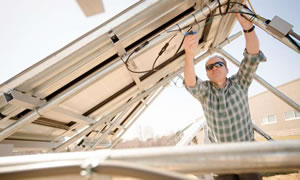Installing solar to combat national security risks in the power grid
 Allison Mills for Phys.org: Distributed microgrid tech can secure the electrical grids at military bases to reduce the impact of cyberattacks, physical attacks from terrorists and natural disasters.
Allison Mills for Phys.org: Distributed microgrid tech can secure the electrical grids at military bases to reduce the impact of cyberattacks, physical attacks from terrorists and natural disasters.
Vulnerabilities in the power grid are one of the most prevalent national security threats. The technical community has called for building up the resiliency of the grid using distributed energy and microgrids for stabilization. Power production from multiple sources increases the difficulty of triggering cascading blackouts, and following an attack or natural disaster, microgrids can provide localized energy security.
In a new paper published in Renewable and Sustainable Energy Reviews, an interdisciplinary team of engineering and energy policy experts from Michigan Technological University says the first step is to outfit military infrastructure with solar photovoltaic (PV)-powered microgrid systems. Their results found that the military needs 17 gigawatts of PV to fortify domestic bases—the systems are technically feasible, within current contractors' skill sets and economically favorable. Full Article:
Comments (0)
This post does not have any comments. Be the first to leave a comment below.
Featured Product

